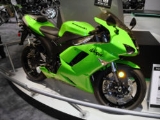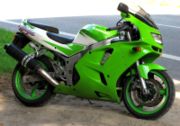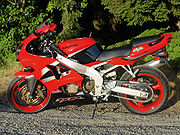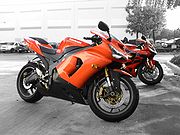
Kawasaki Ninja ZX-6R
Encyclopedia
The Kawasaki Ninja ZX-6R is a Kawasaki
600 class sport motorcycle
.
It was introduced in 1995, and has been constantly updated throughout the years in response to new products from Honda
, Suzuki
, and Yamaha. The ZX series is what was known as the Ninja line of Kawasaki motorcycles in the 1980s and still carries the name today.
 There was a major revamp of the ZX-6R in 1998 with the Launch of the G series. The G series saw no increase in displacement but power went from 100 bhp to 108 bhp thanks to the newly designed airbox. Fairing was revamped, but retained a similar design as far as the headlight, air intakes and screen were concerned. In 2000, the first J series replaced the G, increasing power to 112 bhp by increasing the compression ratio from 11.8:1 to 12.8:1. The J series sported a couple of modernisations including a 180 section rear tyre, second headlight, uprated generator and stick coils (coil on plug) replacing the traditional coil with HT lead.
There was a major revamp of the ZX-6R in 1998 with the Launch of the G series. The G series saw no increase in displacement but power went from 100 bhp to 108 bhp thanks to the newly designed airbox. Fairing was revamped, but retained a similar design as far as the headlight, air intakes and screen were concerned. In 2000, the first J series replaced the G, increasing power to 112 bhp by increasing the compression ratio from 11.8:1 to 12.8:1. The J series sported a couple of modernisations including a 180 section rear tyre, second headlight, uprated generator and stick coils (coil on plug) replacing the traditional coil with HT lead.
With competition from Honda's CBR600F4i
, Suzuki's GSX-R600
, and Yamaha's YZF-R6
getting more aggressive, Kawasaki decided to make an unusual move for the late 2002 models. They increased the capacity of the traditional 600 cc motor to 636 cc with the ZX-6R A1P. This version used the J series bodywork with the only notable differences being the "636" stickers on the fairing. For riders who needed bikes for displacement-restricted racing, Kawasaki also made available a limited production 599 cc version called the Ninja ZX-6RR, but the 636 cc ZX-6R would be their main mass production middleweight sport bike.
 In 2003, there were a number of changes to the ZX-6R, or ZX636 as it is often referred. The engine was fuel injected and engine speed was raised around 500 rpm which resulted in a slight gain in power. Radial-mounted four-piston brakes replaced the previous six-piston brakes and the front forks were now inverted. Chassis improvements resulted in higher rigidity and less weight. An all digital instrument panel was also introduced and a larger ram air inlet moved to the center over the headlight, running through the headstock. The bike, designation B1H, carried over to the 2004 model year with just color scheme changes. The ZX-6RR won the Supersport category award for Masterbike 2004
In 2003, there were a number of changes to the ZX-6R, or ZX636 as it is often referred. The engine was fuel injected and engine speed was raised around 500 rpm which resulted in a slight gain in power. Radial-mounted four-piston brakes replaced the previous six-piston brakes and the front forks were now inverted. Chassis improvements resulted in higher rigidity and less weight. An all digital instrument panel was also introduced and a larger ram air inlet moved to the center over the headlight, running through the headstock. The bike, designation B1H, carried over to the 2004 model year with just color scheme changes. The ZX-6RR won the Supersport category award for Masterbike 2004
and placed third overall.
 In 2005, Kawasaki again revamped the ZX-6R. Engine speed increased again by 1,000 rpm resulting in 113 hp at 12250 rpm. The frame and swingarm were updated, but the main changes from its predecessor lay in the design. The aluminum frame was now painted flat black, fairings were more round, and integrated turn signals were used (euro model). The exhaust was now centrally under the seat (a configuration commonly referred to as an undertail exhaust). Most of these changes were mirrored in the 599 cc ZX-6RR. For the second year in a row, the ZX-6RR again won the Supersport category award for Masterbike 2005
In 2005, Kawasaki again revamped the ZX-6R. Engine speed increased again by 1,000 rpm resulting in 113 hp at 12250 rpm. The frame and swingarm were updated, but the main changes from its predecessor lay in the design. The aluminum frame was now painted flat black, fairings were more round, and integrated turn signals were used (euro model). The exhaust was now centrally under the seat (a configuration commonly referred to as an undertail exhaust). Most of these changes were mirrored in the 599 cc ZX-6RR. For the second year in a row, the ZX-6RR again won the Supersport category award for Masterbike 2005
and placed third overall. The bike carried over to the 2006 model year with minor suspension changes and new color schemes.
After four years of offering their 636 cc ZX-6R for street use and an entirely separate 599 cc ZX-6RR for displacement-restricted racing classes, Kawasaki offered only one ZX-6R for 2007, and it displaced 599 cc. Previous years of the ZX-6R's engines were all built from the same basic design, but the all-new engine for 2007 was redesigned from the crankcase up. In following with what their competitors had already been doing, Kawasaki's new engine featured a stacked gear arrangement in which the crankshaft, primary drive and countershaft are placed in a triangular format for a shorter, more compact powerplant. Now about 40 mm smaller in both length and width and it is said to yield greater cornering clearance. By using a former 125 cc Grand Prix
racer as the ZX-6R’s chief development rider, Tomomi Manako
, Kawasaki claims a focus has been put on track usage. Frame, swingarm, suspension, brakes, and body were completely redesigned and the bike shares very few parts from the previous model. The ZX-6R was carried over to the 2008 model year with just color scheme changes.
For 2009, Kawasaki dramatically changed the appearance of the ZX-6R to match the more angular look of the ZX-10R. The frame was lightened albeit with the same basic construction resulting in 191 kg (421.1 lb) wet as opposed to 205 kg (451.9 lb) in 2008. Kawasaki claims the new ZX-6R is 10 kg lighter than the previous model. The greatest changes for 2009 were the redesign of the exhaust, now carried low and not requiring the thick under-seat construction of 2008 and especially the introduction of the BPF (Big Piston Fork) suspension from SHOWA for a more progressive brake-dive. The 2010 ZX-6R is changing once more with an improved engine and slipper clutch. The exhaust pre-chamber has more space and also limits exhaust noise giving the rider a smoother ride. New double bore intake funnels features two available heights which gives performance upgrades in both high and low engine speeds. The front seat is now lower.
Kawasaki Motorcycle Corporation
Kawasaki motorycles are manufactured by the Motorcycle & Engine division of Kawasaki Heavy Industries at plants in Japan, USA, Philippines, Indonesia and Thailand. The motorcycles have been produced since 1954.-History:...
600 class sport motorcycle
Sport bike
A sport bike, also written as sportbike, is a motorcycle optimized for speed, acceleration, braking, and cornering on paved roads, typically at the expense of comfort and fuel economy in comparison to less specialized motorcycles...
.
It was introduced in 1995, and has been constantly updated throughout the years in response to new products from Honda
Honda
is a Japanese public multinational corporation primarily known as a manufacturer of automobiles and motorcycles.Honda has been the world's largest motorcycle manufacturer since 1959, as well as the world's largest manufacturer of internal combustion engines measured by volume, producing more than...
, Suzuki
Suzuki
is a Japanese multinational corporation headquartered in Hamamatsu, Japan that specializes in manufacturing compact automobiles and 4x4 vehicles, a full range of motorcycles, all-terrain vehicles , outboard marine engines, wheelchairs and a variety of other small internal combustion engines...
, and Yamaha. The ZX series is what was known as the Ninja line of Kawasaki motorcycles in the 1980s and still carries the name today.
History
When Kawasaki introduced the ZX-6R in 1995, it was the first middleweight sport bike with an aluminum frame since the 1992 GSXR600. It had a dry weight of 401.2 lb (182 kg), wet weight of 454 lb (205.9 kg), and was capable of accelerating 0 to 60 mph (0 to 96.6 km/h) in only 3.6 seconds.
Ignition coil
An ignition coil is an induction coil in an automobile's ignition system which transforms the battery's 12 volts to the thousands of volts needed to create an electric spark in the spark plugs to ignite the fuel...
With competition from Honda's CBR600F4i
Honda CBR600F4i
The Honda CBR600F4i was a sport bike produced by Honda from 2001 to 2006.-History:For the 2001 model year Honda released an upgraded version of the popular CBR600F4 with intentions of becoming more competitive in the middleweight sport bike class...
, Suzuki's GSX-R600
Suzuki GSX-R600
The GSX-R600 is a 600 class sport bike in Suzuki's GSX-R series of motorcycles.- History :1992–1993Launched with a water-cooled 599cc inline-4 engine. The first model had the same body specifications as the 1992 GSX-R750, with the smaller engine and carried over through to the 1993 model year with...
, and Yamaha's YZF-R6
Yamaha YZF-R6
Yamaha's YZF-R6 is a 600 class sport bike motorcycle, first introduced in 1998, updated in 2001, 2003, 2006, 2008 and revised in the years in between.-History:...
getting more aggressive, Kawasaki decided to make an unusual move for the late 2002 models. They increased the capacity of the traditional 600 cc motor to 636 cc with the ZX-6R A1P. This version used the J series bodywork with the only notable differences being the "636" stickers on the fairing. For riders who needed bikes for displacement-restricted racing, Kawasaki also made available a limited production 599 cc version called the Ninja ZX-6RR, but the 636 cc ZX-6R would be their main mass production middleweight sport bike.

Masterbike
Masterbike is a contest held on an annual basis to determine the best sport bikes of the year. Motociclismo, a Spanish sport bike magazine, invites cooperating magazines from all over the world Masterbike is a contest held on an annual basis to determine the best sport bikes of the year....
and placed third overall.

Masterbike
Masterbike is a contest held on an annual basis to determine the best sport bikes of the year. Motociclismo, a Spanish sport bike magazine, invites cooperating magazines from all over the world Masterbike is a contest held on an annual basis to determine the best sport bikes of the year....
and placed third overall. The bike carried over to the 2006 model year with minor suspension changes and new color schemes.
After four years of offering their 636 cc ZX-6R for street use and an entirely separate 599 cc ZX-6RR for displacement-restricted racing classes, Kawasaki offered only one ZX-6R for 2007, and it displaced 599 cc. Previous years of the ZX-6R's engines were all built from the same basic design, but the all-new engine for 2007 was redesigned from the crankcase up. In following with what their competitors had already been doing, Kawasaki's new engine featured a stacked gear arrangement in which the crankshaft, primary drive and countershaft are placed in a triangular format for a shorter, more compact powerplant. Now about 40 mm smaller in both length and width and it is said to yield greater cornering clearance. By using a former 125 cc Grand Prix
Grand Prix motorcycle racing
Road Racing World Championship Grand Prix is the premier championship of motorcycle road racing currently divided into three distinct classes: 125cc, Moto2 and MotoGP. The 125cc class uses a two-stroke engine while Moto2 and MotoGP use four-stroke engines. In 2010 the 250cc two-stroke was replaced...
racer as the ZX-6R’s chief development rider, Tomomi Manako
Tomomi Manako
is a Japanese Grand Prix motorcycle road racer who competed in the 125cc class from 1994 to 1998 on a Honda, and the 250cc class in 1999 on a Yamaha. He finished in the top three of the 125cc Championship for three consecutive years, narrowly missing out on the title in 1998.- Early career :He...
, Kawasaki claims a focus has been put on track usage. Frame, swingarm, suspension, brakes, and body were completely redesigned and the bike shares very few parts from the previous model. The ZX-6R was carried over to the 2008 model year with just color scheme changes.
For 2009, Kawasaki dramatically changed the appearance of the ZX-6R to match the more angular look of the ZX-10R. The frame was lightened albeit with the same basic construction resulting in 191 kg (421.1 lb) wet as opposed to 205 kg (451.9 lb) in 2008. Kawasaki claims the new ZX-6R is 10 kg lighter than the previous model. The greatest changes for 2009 were the redesign of the exhaust, now carried low and not requiring the thick under-seat construction of 2008 and especially the introduction of the BPF (Big Piston Fork) suspension from SHOWA for a more progressive brake-dive. The 2010 ZX-6R is changing once more with an improved engine and slipper clutch. The exhaust pre-chamber has more space and also limits exhaust noise giving the rider a smoother ride. New double bore intake funnels features two available heights which gives performance upgrades in both high and low engine speeds. The front seat is now lower.
External links
- 2007 ZX-6R preview from Motorcycle Daily
- 2007 Kawasaki ZX-6R – First Ride from Motorcycle USA
- First Ride: Year 2000 Kawasaki ZX-6R from Motorcycle.com
- Kawasaki ZX-6R reviews Road tests of every Kawasaki ZX-6R model since 1995

